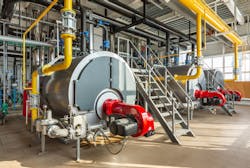Earn Quick Wins with Steam System Efficiency
When I visit a site, my typical conversation with the plant manager centers on how to save the cost of both natural gas and other energy imports. Energy cost is and will always be the highest operational cost for oil refineries or petrochemical plants, following the cost of feedstock. Saving energy makes sense and will remain that way in the future with the trend toward decarbonization. Energy efficiency will emerge from the need to reduce industry emissions and improve production margins despite the low energy prices in the United States compared with Europe and Asia.
These discussions typically start with the low-hanging fruit, the energy savings we can realize quickly while minimizing the impact on operations and capital expenditures. To accomplish this, operators may need to undergo additional training and focus on applying some maintenance best practices.
As an example, let’s look at steam systems. Steam is used on all sites for many purposes. These include:
- Steam reboilers and heaters to process heat or reboil streams
- Cooling hot process streams and driving steam turbines, which can be back-pressure or condensing steam turbines
- Stripping steam to improve the quality of a process stream
- Vacuum ejector systems that use steam when a vacuum is required
- Steam tracing and tank heating to keep feedstock, intermediate streams and products at a minimum temperature
Let’s explore some of the efficiency issues with these steam systems.
One of my favorite topics to review is the performance and steam usage of vacuum ejectors.
5 Keys to Optimizing a Steam System
Using back-pressure steam turbines is a highly efficient way to generate shaft power and drive pumps, compressors, fans and blowers. They take advantage of high-pressure steam and produce an equivalent amount of lower-pressure steam. This lower-pressure steam can be used for other heating or stripping-steam purposes in the plant. Typically, the cycle efficiency of these drivers ranges between 80% and 85% depending on the boiler efficiency. As an alternative, let-down systems can generate this lower-pressure steam, yet do not create any shaft power and are therefore quite inefficient. Similarly, condensing turbines are not very effective either because the outlet steam is condensed with cooling water under vacuum conditions. The typical cycle efficiency of these condensing steam turbines falls below 30%.
Considering these scenarios, the best approach to operate your steam system involves:
- Generating steam at the highest pressure;
- Consuming steam at the lowest possible pressure;
- Minimizing the use of let-down systems to generate lower-pressure steam levels;
- Maximizing the use of back-pressure steam turbines to balance the need for lower pressure steam; and,
- Avoiding the use of condensing steam turbines where possible.
Don’t Forget About Steam Traps
Steam traps have another issue I frequently encounter. Low-pressure steam systems commonly use steam traps to remove condensate from steam tracing lines, low-pressure steam interconnecting lines, small steam heaters and tank heaters. The steam trap separates the condensate from the steam, and this condensate is returned to the utility plant. Each plant may have thousands of these steam traps. Plants often neglect steam traps, which can lead to corrosion and erosion and frequent testing, repair or replacement. Without proper maintenance, operators may need to open a bypass valve to purge the lines of condensate. While the steam plume is visible, the operator will know the condensate has been adequately drained from the system. This process leads to wasted steam. Condensate drains to the ground, and bypass valves were not designed for continuous use. In this case, the best practice is to have a permanent maintenance team dedicated to steam traps that continuously test the functionality of the traps and replace or repair them as needed.
Enhance Vacuum Ejector Performance
One of my favorite topics to review is the performance and steam usage of vacuum ejectors. Vacuum ejectors, often found in a series of three or four ejectors, typically use middle-pressure steam (motive steam) to create a vacuum for a distillation column or surface condenser. Removing inert gases or light materials that can’t be condensed creates a vacuum. A common issue is that motive steam must be near saturation temperature to be effective. I have seen the first stage of the ejector — the biggest in size and steam consumption – gets a full load of motive steam, while the second and third stages are unused or used incorrectly. By balancing the steam across the three stages correctly, vacuum often can be improved using less motive steam.
These are just a few examples of easy-to-implement changes to the operation of a steam system with no or very small investments – the so-called low-hanging fruit. In future columns, I will expand on this topic for other energy systems as well.
About the Author
Michiel Spoor, Energy Saver columnist
Energy Saver columnist
Michiel Spoor has over 28 years of energy experience, working worldwide as a leader in oil and gas consulting. He has a master’s degree in Chemical Process Technology from the Delft University of Technology in The Netherlands.
His passion is to shape the future of energy transition, renewables, global carbon emission reduction and energy efficiency. He has had diverse roles in engineering and consulting. He started his career as a process design engineer at Badger BV in The Hague where he brought plants from conceptual design, through process simulation, equipment designs all the way to commissioning and start-up.
As a consultant Michiel specializes in energy management and energy transition and has held senior positions in various companies like KBC, Accenture and KBR. Currently Michiel works as a Principal Consultant Energy with KBC Advanced Technology in Houston, Texas. He has worked on six continents on various projects and positions in oil refining, petrochemicals, fertilizers, LNG and renewables.
Michiel has authored and contributed to numerous papers and conferences on the topics of refinery energy efficiency and refinery carbon management. He is internationally recognized as an authority on this subject.

